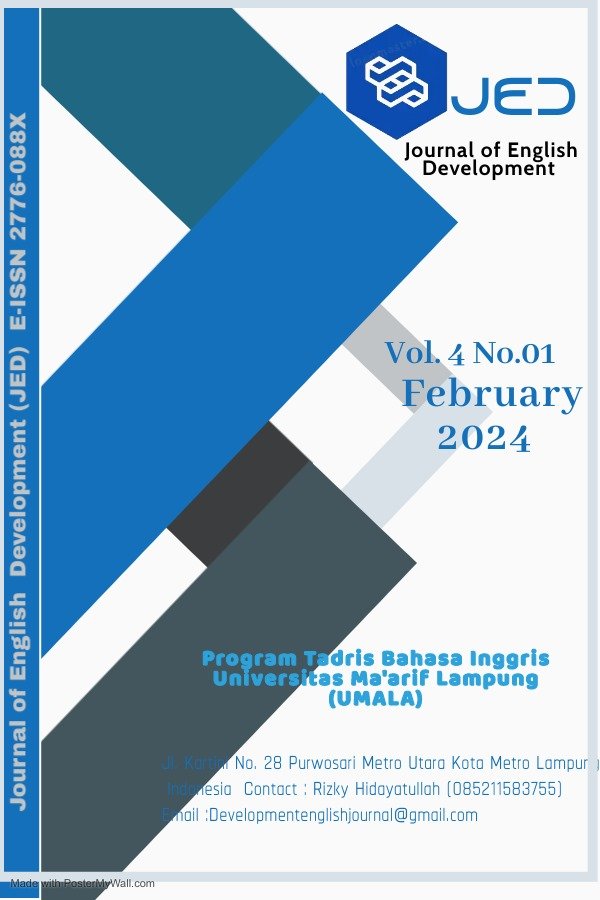Development of "Eng-Lab" Application Based on Needs Analysis to Improve Professional English in Metro City
English
DOI:
https://doi.org/10.25217/jed.v4i01.4372Keywords:
Eng-Lab Application, Professional English, Needs BasedAbstract
The research focuses on the development of "Eng-Lab", an application designed to improve professional English skills in Metro Cities. This research aims to enrich educational technology literature and contribute practical solutions to English language learning challenges. Funded by LITABDIMAS, Director General of Education at the Ministry of Religion, this research identifies English as an important communication tool in the global work environment. The methodology used is a needs-based approach, combining expert insights and participant feedback through interviews and surveys. The result is an innovative, adaptive and interactive learning tool tailored to the user's needs. The app, assessed for its effectiveness, promises to overcome language barriers in the job market and increase economic growth. The study concludes that Eng-Lab, developed through extensive analysis and user feedback, offers a valuable and responsive educational tool for improving professional English proficiency in a diverse and developing economy
References
Aka, K. A. (2019). Integration Borg & Gall (1983) and Lee & Owen (2004) models as an alternative model of design-based research of interactive multimedia in elementary school. Journal of Physics: Conference Series, 1318(1). https://doi.org/10.1088/1742-6596/1318/1/012022
Brown, H. D. (2001). Teaching by Principles: An Interactive Approach to Language Pedagogy. New York: Addison Wesley Longman.
Cruz, F. O. A. M. (2019). Evidence on the use of mobile apps during the treatment of breast cancer: Systematic review. JMIR MHealth and UHealth, 7(8). https://doi.org/10.2196/13245
Czaja, S. (2006). Factors predicting the use of technology: Findings from the Center for Research and Education on Aging and Technology Enhancement (CREATE). Psychology and Aging, 21(2), 333–352. https://doi.org/10.1037/0882-7974.21.2.333
Fu, Y. (2021). Perceptions of Non-English Major College Students on Learning English Vocabulary with Gamified Apps. International Journal of Emerging Technologies in Learning, 16(18), 268–276. https://doi.org/10.3991/ijet.v16i18.24125
Hollinderbäumer, A., Hartz, T., & Ückert, F. (2013). Education 2.0-How has social media and Web 2.0 been integrated into medical education? A systematical literature review. GMS Zeitschrift Für …. Retrieved from https://www.ncbi.nlm.nih.gov/pmc/articles/PMC3589682/
Muthmainnah. (2022). Adoption Social Media-Movie Based Learning Project (SMMBL) To Engage Students’ Online Environment. Educational Administration: Theory and Practice, 28(1), 22–36.
Nikimaleki, M. (2022). Effects of a collaborative AR-enhanced learning environment on learning gains and technology implementation beliefs: Evidence from a graduate teacher training course. Journal of Computer Assisted Learning, 38(3), 758–769. https://doi.org/10.1111/jcal.12646
Nur’Aini, I., Utami, P. D. T., & Naima, L. N. (2022). Pelatihan Berbicara Bahasa Inggris bagi Santri di Pakisaji, Kab. Malang. … : Jurnal Pengabdian …. Retrieved from http://journal.sinergicendikia.com/index.php/emp/article/view/177
Park, E. (2022). A needs analysis to develop new curriculum for Korean college students in higher education. Indonesian Journal of Applied Linguistics, 12(1), 79–87. https://doi.org/10.17509/ijal.v12i1.46564
Polakova, P. (2022). Vocabulary Mobile Learning Application in Blended English Language Learning. Frontiers in Psychology, 13. https://doi.org/10.3389/fpsyg.2022.869055
Safar, A. H. (2017). The effectiveness of using augmented reality apps in teaching the english alphabet to kindergarten children: A case study in the state of Kuwait. Eurasia Journal of Mathematics, Science and Technology Education, 13(2), 417–440. https://doi.org/10.12973/eurasia.2017.00624a
Un, C. A., Cuervo-Cazurra, A., & Asakawa, K. (2010). R&D collaborations and product innovation. Journal of Product Innovation Management. https://doi.org/10.1111/j.1540-5885.2010.00744.x
van Raaij, E. M. (2008). The acceptance and use of a virtual learning environment in China. Computers and Education, 50(3), 838–852. https://doi.org/10.1016/j.compedu.2006.09.001
Zou, B., & Li, J. (2015). Exploring mobile apps for English language teaching and learning. (2015), 564–568. https://doi.org/10.14705/rpnet.2015.000394

Downloads
Published
How to Cite
Issue
Section
License
Copyright (c) 2024 Rizky Hidayatullah, Umar Alfaruq A. Hasyim, Dimas Dwi Tobing

This work is licensed under a Creative Commons Attribution-ShareAlike 4.0 International License.





